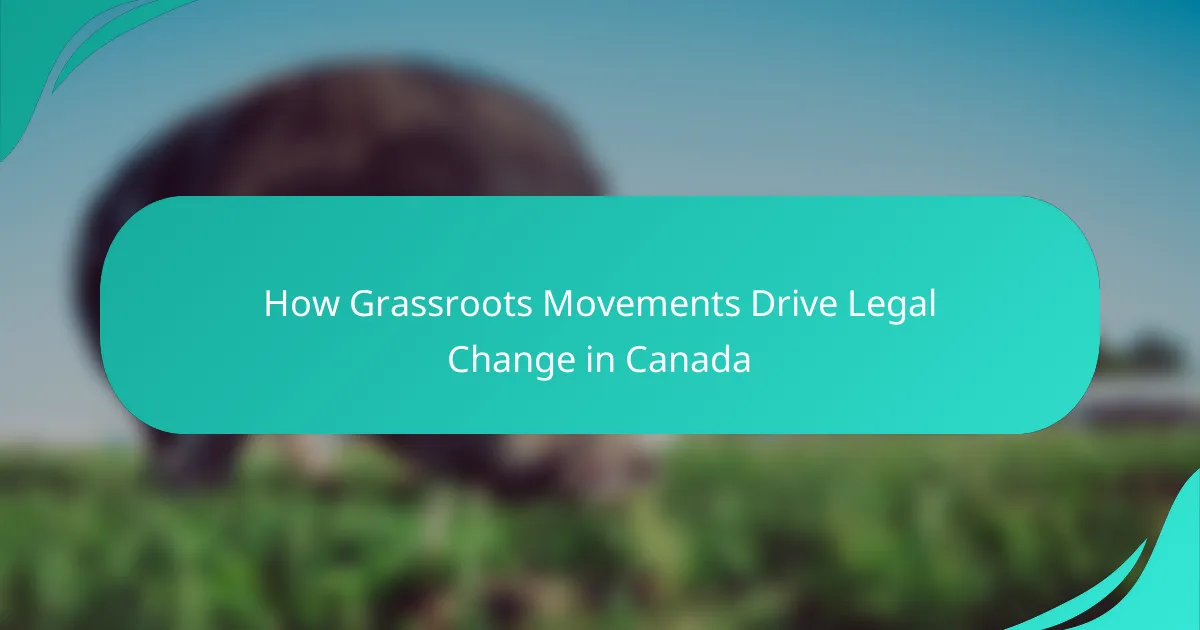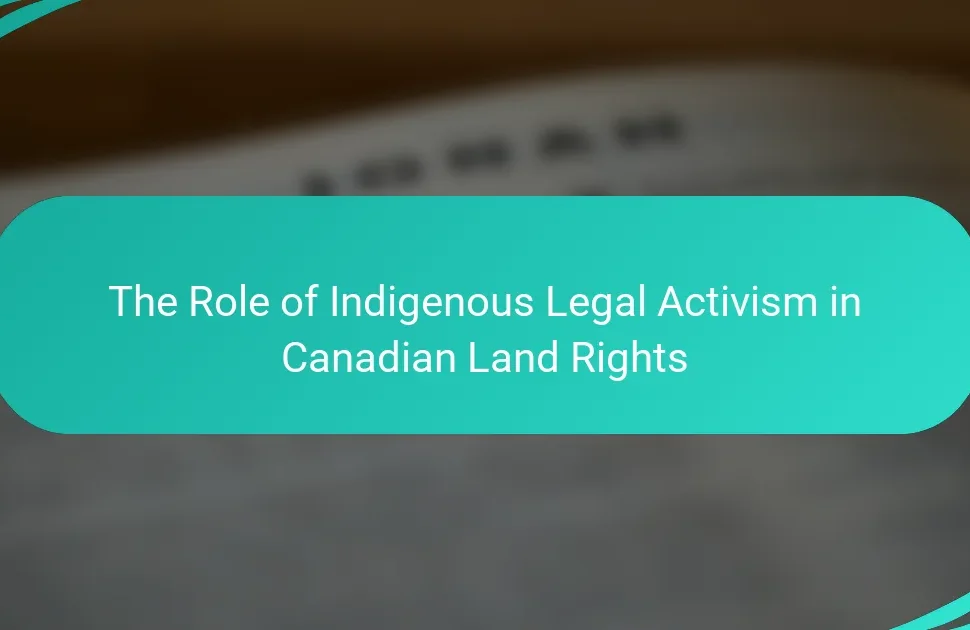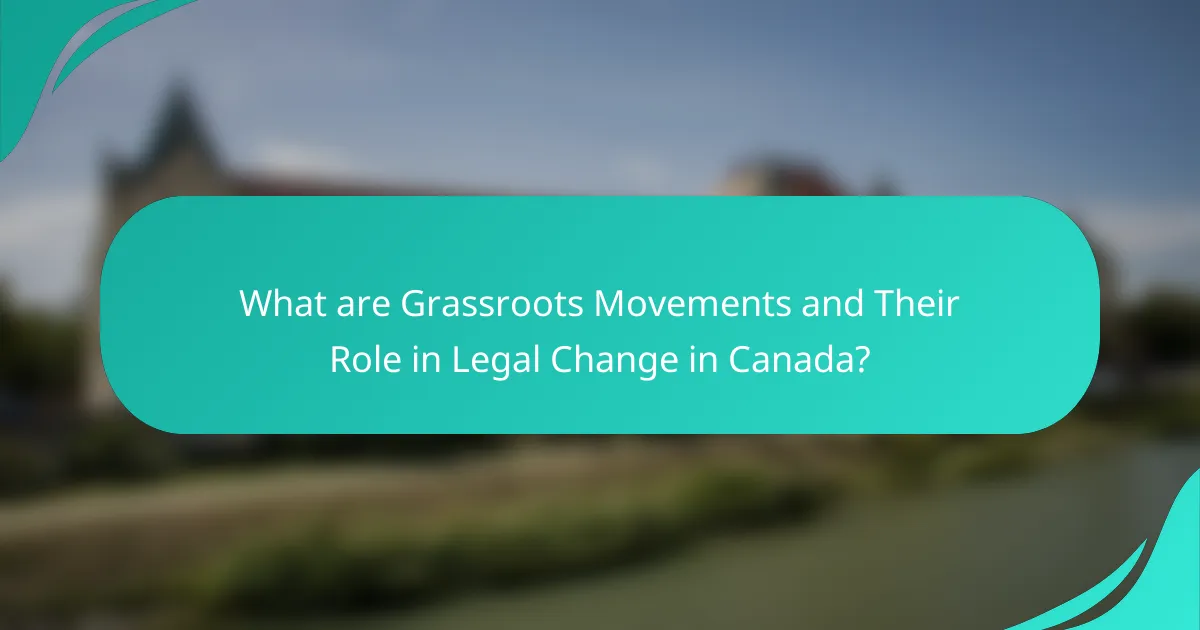
What are Grassroots Movements and Their Role in Legal Change in Canada?
Grassroots movements are collective efforts by ordinary people to advocate for social, political, or legal change. In Canada, these movements play a crucial role in influencing legislation and policy. They often arise in response to perceived injustices or unmet needs within communities. Grassroots movements mobilize citizens to raise awareness and push for reform. They can include protests, petitions, and community organizing. Historical examples include the women’s suffrage movement and Indigenous rights campaigns. These movements have successfully led to significant legal changes, such as the legalization of same-[censured] marriage in 2005. Their impact is evident in shaping public opinion and pressuring lawmakers to act.
How do Grassroots Movements initiate legal change?
Grassroots movements initiate legal change by mobilizing community support around specific issues. They raise awareness through campaigns and advocacy efforts. These movements often engage in lobbying government officials to influence legislation. They may also organize protests to draw public attention to their cause. Legal change can be pursued through petitions that gather signatures to demonstrate public support. Some grassroots movements file lawsuits to challenge existing laws or regulations. They utilize social media to amplify their message and connect with broader audiences. Historical examples include the civil rights movement, which led to significant legal reforms in the United States.
What are the key characteristics of effective Grassroots Movements?
Effective grassroots movements are characterized by community engagement, clear goals, and strong leadership. Community engagement fosters inclusivity and mobilizes a diverse group of supporters. Clear goals provide direction and purpose, making it easier to rally support. Strong leadership is essential for organizing efforts and maintaining momentum.
Additionally, effective grassroots movements often utilize strategic communication to spread their message. They leverage social media and traditional media to reach wider audiences. Collaboration with other organizations can amplify their impact. Lastly, adaptability to changing circumstances helps these movements remain relevant and effective.
How do Grassroots Movements mobilize community support?
Grassroots movements mobilize community support by fostering local engagement and collective action. They utilize social media platforms to spread awareness and gather support quickly. These movements often focus on specific issues that resonate with community members. They encourage participation through events, meetings, and outreach efforts. Grassroots organizations often build coalitions with local groups to amplify their message. They promote shared values and goals that unite individuals. Research shows that grassroots efforts can lead to significant policy changes, as seen in various Canadian movements. For example, the Idle No More movement successfully raised awareness about Indigenous rights and led to national discussions on related policies.
Why is understanding Grassroots Movements important for legal change?
Understanding grassroots movements is crucial for legal change because they mobilize community support and influence policy. Grassroots movements often represent the voices of marginalized groups. They raise awareness about social issues that require legal reform. For example, the civil rights movement in the 1960s led to significant legal changes in the United States. These movements can effectively advocate for specific legislation by organizing campaigns and rallies. They also engage in lobbying efforts to persuade lawmakers. Research shows that public pressure from grassroots initiatives can lead to legislative action. In Canada, movements like Idle No More have successfully prompted discussions on Indigenous rights and environmental policies.
What impact do Grassroots Movements have on public policy?
Grassroots movements significantly influence public policy by mobilizing community support and raising awareness on specific issues. They often serve as catalysts for social change. For instance, grassroots campaigns can lead to legislative reforms by highlighting public concerns. An example is the environmental movement, which has shaped policies on climate change in Canada. Research shows that grassroots efforts can increase voter engagement, leading to policy shifts. According to a study by the Institute for Research on Public Policy, grassroots activism has been crucial in advancing social justice legislation. These movements can also pressure elected officials to respond to constituents’ needs. Overall, grassroots movements play a vital role in shaping and transforming public policy.
How do Grassroots Movements influence lawmakers and legal frameworks?
Grassroots movements influence lawmakers and legal frameworks by mobilizing public support and raising awareness on critical issues. These movements often organize campaigns that highlight specific social injustices or policy failures. They utilize petitions, protests, and social media to amplify their messages. This public pressure can compel lawmakers to take action or reconsider existing laws. For example, the Black Lives Matter movement has prompted discussions on police reform in various jurisdictions. Research shows that sustained grassroots activism can lead to legislative changes, as seen in the legalization of marijuana in several Canadian provinces. By shaping public opinion, grassroots movements create an environment conducive to legal reform.
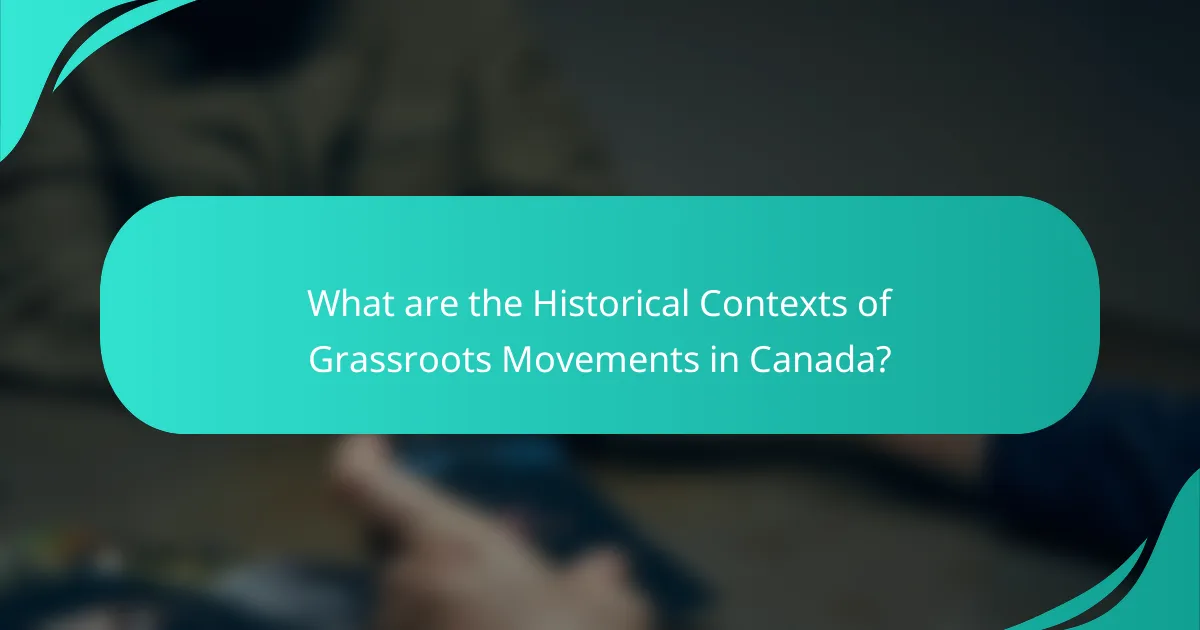
What are the Historical Contexts of Grassroots Movements in Canada?
Grassroots movements in Canada have a rich historical context rooted in social justice and political activism. These movements emerged in response to various societal issues, including Indigenous rights, labor rights, and environmental concerns. The suffrage movement in the early 20th century marked a significant grassroots effort, advocating for women’s voting rights.
In the 1960s and 1970s, the civil rights movement inspired Canadian activists to address systemic inequalities. The formation of organizations like the Black Panthers in Canada highlighted racial injustices and called for change. Environmental movements gained momentum in the 1980s, focusing on issues like pollution and conservation.
Indigenous activism has been pivotal, with events like the Oka Crisis in 1990 bringing national attention to land rights. The Idle No More movement in 2012 further galvanized support for Indigenous sovereignty and environmental stewardship. These historical contexts illustrate how grassroots movements in Canada have consistently sought to challenge the status quo and drive legal and social change.
How have Grassroots Movements evolved over time in Canada?
Grassroots movements in Canada have evolved significantly over time. Initially, they focused on local community issues and social justice. In the 1960s, movements like the Indigenous rights movement gained momentum. They sought to address historical injustices and land claims. The 1980s saw the rise of environmental activism, responding to ecological concerns. These movements utilized direct action and public protests to influence policy. By the 2000s, digital platforms enabled broader mobilization and awareness. Social media played a crucial role in amplifying grassroots efforts. Recent movements, such as Black Lives Matter Canada, highlight ongoing social issues. Overall, grassroots movements have adapted to societal changes and technological advancements.
What significant legal changes have been driven by Grassroots Movements in the past?
Grassroots movements have driven significant legal changes, notably in civil rights and environmental protection. The Civil Rights Movement in the 1960s led to the Civil Rights Act of 1964 in the United States. This act prohibited discrimination based on race, color, religion, [censured], or national origin. Women’s suffrage movements resulted in the 19th Amendment, granting women the right to vote in 1920. Environmental movements contributed to the establishment of the Environmental Protection Agency in 1970 and the passage of the Clean Air Act. These legal changes exemplify how grassroots activism can influence legislation and policy.
How have social movements shaped Canadian legal history?
Social movements have significantly shaped Canadian legal history by advocating for social justice and equality. They have influenced legislation and legal reforms across various issues. The women’s suffrage movement led to the right to vote for women in 1917. Indigenous rights movements have resulted in landmark legal decisions, such as the Calder case in 1973, which recognized Aboriginal land rights. The [censured] rights movement has led to the legalization of same-[censured] marriage in 2005. Environmental movements have prompted legal frameworks for environmental protection. These movements have mobilized public opinion and pressured governments to enact change, thereby altering the legal landscape in Canada.
What are some notable examples of successful Grassroots Movements in Canada?
Notable examples of successful grassroots movements in Canada include the Indigenous rights movement and the climate justice movement. The Indigenous rights movement has led to significant legal changes, including the recognition of land claims and treaties. The 1995 Supreme Court case, Delgamuukw v. British Columbia, was influenced by grassroots activism advocating for Indigenous land rights. The climate justice movement has mobilized Canadians to demand action on climate change. Events like the 2019 Global Climate Strike saw millions participating across Canada, pressuring the government for stronger climate policies. These movements illustrate how grassroots efforts can effect substantial legal and policy changes in Canada.
How did the environmental movement achieve legal reforms?
The environmental movement achieved legal reforms through grassroots activism and public awareness campaigns. Activists organized protests and rallies to highlight environmental issues. They mobilized communities to advocate for policy changes at local and national levels. Legal challenges were filed against corporations and governments violating environmental laws. Landmark cases, such as the 1970s Supreme Court ruling in Canada, set precedents for environmental protection. The introduction of legislation like the Canadian Environmental Protection Act in 1999 was influenced by these efforts. Public support for environmental causes grew, leading to increased political pressure for reform. This combination of activism, legal action, and public engagement significantly advanced environmental legislation.
What role did Indigenous movements play in shaping legal recognition and rights?
Indigenous movements have played a crucial role in shaping legal recognition and rights in Canada. These movements have advocated for the acknowledgment of Indigenous sovereignty and treaty rights. They have mobilized communities to challenge discriminatory laws and policies. Landmark events, such as the 1969 White Paper protests, highlighted the need for legal reforms. Indigenous activism has led to significant legal cases, including the Calder case in 1973, which recognized Aboriginal title. The Supreme Court’s decision in Delgamuukw in 1997 further affirmed Indigenous land rights. Additionally, the Truth and Reconciliation Commission has influenced public policy and legal frameworks. Overall, Indigenous movements have been instrumental in advancing legal recognition and rights in Canada.
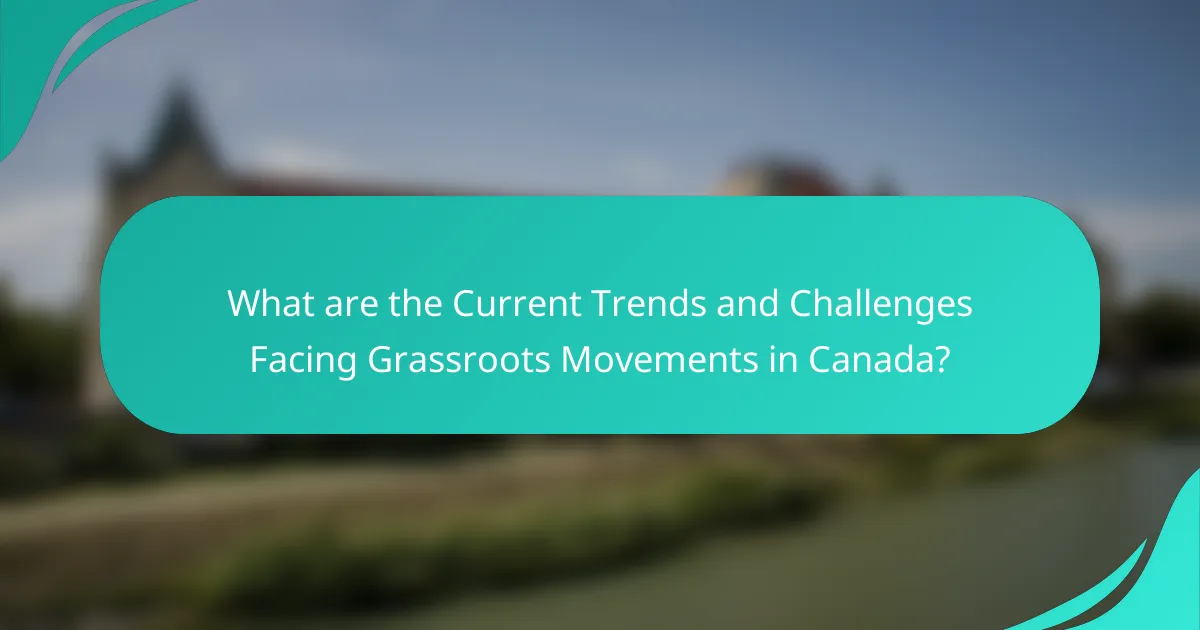
What are the Current Trends and Challenges Facing Grassroots Movements in Canada?
Current trends in grassroots movements in Canada include increased digital engagement and intersectionality. Movements are leveraging social media to mobilize supporters and spread awareness. This digital shift allows for rapid information dissemination and broader reach. Additionally, there is a focus on intersectionality, addressing multiple forms of discrimination simultaneously.
Challenges facing these movements involve funding constraints and political pushback. Many grassroots organizations struggle to secure sustainable funding. This limits their capacity to organize and advocate effectively. Political resistance can also undermine their efforts, especially when advocating for controversial issues.
The combination of these trends and challenges shapes the landscape of grassroots activism in Canada today.
How do contemporary Grassroots Movements address current legal issues?
Contemporary grassroots movements address current legal issues by mobilizing community support and advocating for policy changes. They often leverage social media to raise awareness and organize campaigns. These movements focus on specific legal challenges, such as environmental protection or social justice. They engage in lobbying efforts to influence lawmakers directly. Grassroots organizations frequently conduct research to support their claims and proposals. For instance, movements have successfully pushed for changes in laws related to climate action in Canada. They also utilize public demonstrations to draw attention to legal injustices. Overall, grassroots movements create pressure on the legal system to adapt to the needs of the community.
What challenges do Grassroots Movements face in the digital age?
Grassroots movements face significant challenges in the digital age. One major challenge is information overload. The vast amount of content online can dilute their messages. Another challenge is digital misinformation. False narratives can undermine their credibility and efforts. Additionally, there is the issue of platform algorithms. These algorithms often prioritize mainstream content over grassroots initiatives. Privacy concerns also pose a challenge. Activists may fear surveillance and data breaches. Funding is another critical issue. Many grassroots movements struggle to secure financial support in a crowded digital landscape. Lastly, digital divides exist. Not all communities have equal access to technology, limiting engagement. These challenges hinder the effectiveness of grassroots movements in advocating for legal change.
How do funding and resources impact the effectiveness of Grassroots Movements?
Funding and resources significantly enhance the effectiveness of grassroots movements. Adequate funding allows for comprehensive outreach strategies. This includes organizing events, mobilizing volunteers, and creating educational materials. Resources such as technology enable better communication and coordination. For example, social media platforms can amplify messages and increase engagement. Grassroots movements with sufficient financial backing can hire skilled staff and experts. This leads to more informed advocacy and strategic planning. Research indicates that movements with robust funding are more likely to achieve their goals. A study by the National Democratic Institute found that well-resourced movements can increase their impact by up to 50%.
What strategies can Grassroots Movements employ to drive legal change effectively?
Grassroots movements can employ several strategies to drive legal change effectively. These strategies include mobilizing community support, raising awareness through campaigns, and leveraging social media platforms. Mobilizing community support involves organizing local events and rallies to gather public backing. Raising awareness through campaigns can educate the public about specific legal issues and injustices. Utilizing social media platforms allows grassroots movements to reach a wider audience quickly. Collaborating with legal experts can provide necessary insights into the legislative process. Engaging in lobbying efforts can influence policymakers directly. Building coalitions with other organizations can strengthen the movement’s voice. Documenting personal stories can humanize legal issues, making them more relatable. These strategies have proven effective in various historical contexts, demonstrating the power of grassroots advocacy in legal reform.
How can Grassroots Movements leverage social media for advocacy?
Grassroots movements can leverage social media for advocacy by utilizing platforms to amplify their message. Social media allows for rapid dissemination of information, reaching a wide audience quickly. It enables grassroots organizations to engage directly with supporters and mobilize them for action. Campaigns can be designed to encourage sharing, increasing visibility and support.
For instance, hashtags can unify messages and create trending topics, drawing attention to specific issues. Visual content, such as videos and infographics, can effectively communicate complex ideas in an accessible manner. Social media also facilitates real-time interaction, allowing movements to respond to current events and public sentiment swiftly.
According to a study by the Pew Research Center, 69% of adults in Canada use social media, making it an essential tool for outreach. The effectiveness of social media in advocacy is evidenced by the success of movements like #MeToo and Black Lives Matter, which gained significant traction through online platforms.
What are best practices for building coalitions among diverse groups?
Best practices for building coalitions among diverse groups include fostering open communication and mutual respect. Establishing clear goals is essential for aligning interests. Involving all stakeholders in decision-making promotes ownership and commitment. Regular meetings help maintain engagement and address conflicts early. Utilizing a shared platform for collaboration enhances transparency and trust. Celebrating small wins can motivate participants and strengthen relationships. Research shows that diverse coalitions are more effective in achieving social change, as they bring varied perspectives and resources.
What are the key takeaways for engaging in Grassroots Movements for legal change?
Grassroots movements for legal change require community engagement and strategic organization. Building a coalition of supporters amplifies voices and increases influence. Clear messaging is essential to communicate goals effectively to the public and policymakers. Utilizing social media can enhance outreach and mobilization efforts. Consistent advocacy efforts, including petitions and public demonstrations, maintain momentum and visibility. Collaborating with legal experts ensures the movement’s strategies align with legal frameworks. Historical examples, such as the Canadian women’s suffrage movement, demonstrate the effectiveness of grassroots advocacy in achieving legal reforms. Engaging diverse communities fosters inclusivity and broadens support for the cause.
Grassroots movements are collective efforts by ordinary citizens in Canada advocating for social, political, or legal change, often in response to perceived injustices. This article explores the role of grassroots movements in initiating legal reforms, highlighting their strategies for mobilizing community support, raising awareness, and influencing policymakers. Key characteristics of effective movements, historical contexts, and notable examples of successful advocacy are discussed, alongside current trends and challenges faced in the digital age. The impact of grassroots activism on public policy and legal frameworks is examined, emphasizing its significance in shaping Canadian legal history and addressing contemporary legal issues.
